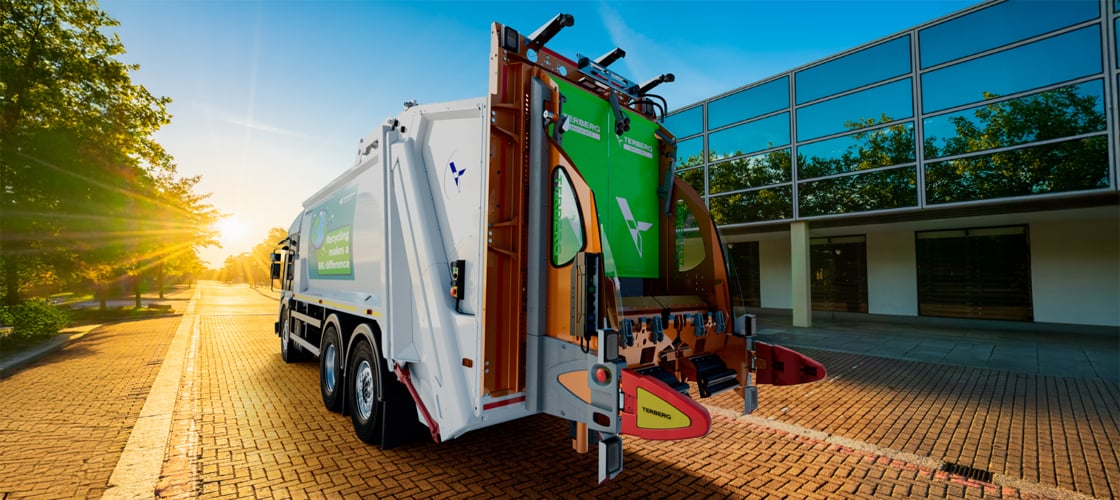Electric bin lifts: proven, sustainable, and cost-effective waste collection

In an ideal scenario, the answer would simply be to make the switch from diesel-powered refuse collection vehicles (RCVs) to electric vehicles (EVs or eRCVs). That way, carbon emissions from your fleet would be significantly reduced and you’d be firmly on the road to net zero. However, before those benefits can be realised, a substantial investment surrounding infrastructure planning and implementation is required to accommodate an electric fleet. It may not be an immediate solution, but a longer-term ambition that needs careful planning and consideration.
In the interim, Terberg Matec UK has the perfect alternative to help customers take that critical first step towards their sustainability goals: the Terberg electric-powered bin lift range. Cleverly designed to mirror Terberg’s existing, market-leading hydraulic-powered bin lifts, the electric bin lift’s mechanical and control components are identical to its hydraulic-powered derivative, making it easy for RCV operators to pick up and use. After entering the market back in 2011, the fully automatic electric bin lift now accounts for more than a third of Terberg bin lift sales in the UK and its popularity is only set to grow. In fact, around 800 electric bin lifts are delivered into service worldwide every year.
“Our electric bin lift is a proven, no-risk, affordable solution for customers on their journey to a more sustainable future,” said Paul Rochester, General Sales Manager, Terberg Matec UK. “It’s the ideal first step – it means customers don’t need to immediately invest in charging infrastructure; they can start saving operational costs and reducing emissions as soon as the trucks are delivered.”
The lightbulb moment: why go electric?
An electric bin lift offers a whole host of advantages over and above its hydraulic equivalent:
Environmentally friendly
It almost goes without saying that an electric bin lift is a much more sustainable option than a hydraulic one, reducing the overall impact to the environment. To test the full extent of this, a field trial was conducted by Terberg Matec UK which compared the electric bin lift to the hydraulic. This trial took place over a period of two weeks, during which the RCVs travelled roughly 2,700 miles and collected 275 tonnes of waste. This particular trial demonstrated that the electric lift offered a 9.7% reduction in fuel consumption. This reduction is directly attributable to a potential annual carbon saving of 3,500 kg of CO2 emissions per vehicle – not an insignificant figure.
Low operating costs
Due to this reduction in fuel consumption and usage, the electric-powered bin lift is a more cost-effective and affordable solution, enabling considerable savings across the lifetime of its use.
Almost silent operation
When the electric bin lift is being operated, there is no need for the engine to be revved, unlike its hydraulic equivalent. This vastly reduces noise pollution and results in less disturbance to the general public. It also makes the bin lift ideal for operating in more noise-sensitive environments such as schools, hospitals, and care homes, and aids with time-sensitive collections that are early in the morning or late at night. It is one of the quietest bin lifts on the market today.
Common, familiar features
Another major benefit of the electric bin lift is that it was designed specifically to share common features and components with the Terberg hydraulic-powered derivative. It’s because of this that training for the electric bin lift is vastly simplified; if an operator is trained on the hydraulic bin lift, they will essentially already be trained to use the electric derivative. This familiarity only serves to instil greater confidence for operators in the electric-powered bin lift range during collection rounds.
Creating a buzz at Heathrow
These benefits and more are currently being realised by Heathrow, who recently selected an Elite+ Narrow chassis with an Olympus 10 body and OmniDEL electric bin lift to support with the removal of foreign object debris (FOD) from the airfield. In a continual bid to reduce its environmental impact and achieve its sustainability goals, the airport selected the electric bin lift due to its ability to provide better, more efficient fuel economy, lower operating costs, and almost silent operation.
“The compact size and key safety features of the new RCV will make a huge difference to our airside waste collections, not to mention the many economic benefits made possible by the electric bin lift,” said Stuart Roblin, Motor Transport Manager, Heathrow Airport. “We are very satisfied with the vehicle and grateful for the comprehensive operator and technical training provided by Dennis Eagle’s team. We look forward to its many years of airside operational use.”
The electric bin lift is helping Dennis Eagle and Terberg Matec UK customers all over the country get a step closer to achieving their sustainability targets. The Terberg electric-powered bin lift range offers a proven, no-risk solution for the sustainable waste collection fleets of the future.